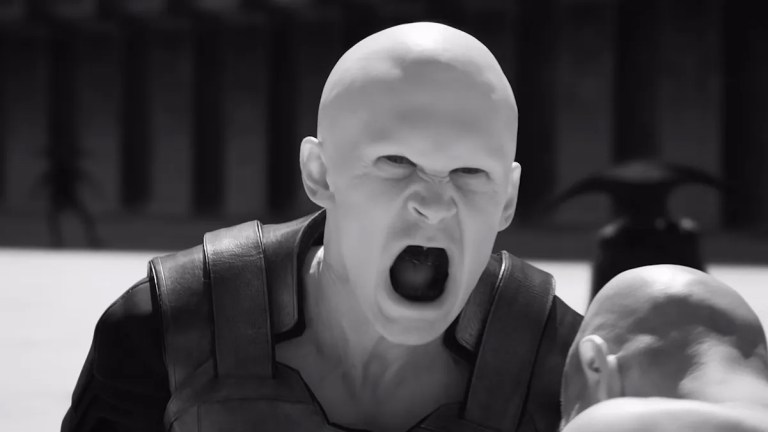Dune 2: Austin Butler’s Feyd-Rautha Echoes One of the Greatest Movie Villains
The new trailer for Dune: Part Two teases a better look at its most chilling villain: Austin Butler as Feyd-Rautha. And believe it or not, he has some real-life influences.

It is said more than once in Frank Herbert’s Dune that fear is the mind-killer; it’s the little death that brings obliteration. This might be so, but after getting a better look at the Oscar-nominated Austin Butler as Feyd-Rautha, the unofficial prince of House Harkonnen, it’s worth remembering there are some things that are the killer of the whole damn body. And in the latest Dune: Part Two trailer, Feyd-Rautha appears to be a manifestation of death itself.
Shaved balder than a tech CEO and licking his knives like they were lovers, he makes a grotesque and immediate impression when new fans are warned “Feyd-Rautha… he’s psychotic.” That he is, but Feyd’s also more than just a simple assassin sent by the Padishah Emperor of the Imperium (Christopher Walken). In fact, Feyd-Rautha is a bit like Paul Arterides’ dark doppelgänger. Here is another product of a great house who’s been carefully selected for even greater breeding by the Bene Gesserit. He also intentionally echoes one of the greatest villains in cinema history (not to mention history, history).
You’ve gotten a glimpse of this in every trailer for Dune: Part Two where we see a world desaturated to simple black and white. Butler’s Feyd-Rautha looks positively feral in monochrome while battling enemies in a gladiatorial arena. But if the scene looks reminiscent of Ridley Scott’s Gladiator, that’s because it’s intentional, albeit not for the reasons you might suspect.
To give away a very small spoiler from the novel Dune, and to provide context of Feyd-Rautha’s big entrance in blood and sand, when we meet this nephew of the vile Baron Harkonnen (Stellan Skarsgård in the movie), he is revealed to be a perverse sadist who gets his kicks by slaughtering enslaved gladiators before cheering crowds on the Harkonnen homeworld of Giedi Prime. The sequence you see in the Dune: Part Two trailer occurs on Feyd-Rautha’s 17th birthday (at least on the page). To commemorate the occasion, he is festively killing his 100th gladiatorial opponent.
It’s savage and barbaric, but at least to the cheering crowd, it looks defiantly brave. Before them is the presumed heir of the Baron’s title and power, and he is risking his life for their entertainment. Of course, the rich only play games with the poor if the dice is loaded.
As we read the chapter partially from Feyd-Rautha’s point-of-view, we learn that most of the gladiators he’s skewered in the past were drugged and set up to fail. On his birthday, however, he decided he wants to give the crowd a better show. So his opponent, one of Duke Leto Atreides’ men taken prisoner during the surprise attack on Arrakis, is stone cold sober when he fights Feyd-Rautha. Still, the slave does not have a poisoned dagger like the Harkonnen princeling, who needs but to scratch his foe to kill him. Additionally, and unbeknownst to the crowd, Feyd-Rautha’s men have brainwashed the opponent to freeze when Feyd utters a single word (“scum”). At which point, he’ll become easy pickings for either the poisonous dagger or the clean one.
To be released in 2024, it is impossible to watch Dune: Part Two’s scene and not think of the end of Gladiator where the Emperor Commodus (Joaquin Phoenix) dares to cross the sand of the arena and do mortal combat with his arch-nemesis, the slave Maximus (Russell Crowe). It is an act of bravery meant to restore confidence from the cheering crowd in the emperor—and it theoretically is meant to end safely since Maximus has been mortally wounded ahead of the fight, with the injury then hidden by his armor.
Given Herbert published Dune decades before Gladiator, some might be tempted to say Scott borrowed from the literary sci-fi classic. However, the truth is they both pull from the same source: the twisted reign of the real-life Roman Emperor Commodus. Ruling briefly and bloodily from 177 to 192 A.D., Commodus was a lot like Feyd-Rautha in that he was groomed for the throne from the start by his predecessor, albeit the Emperor Marcus Aurelius was no monster like the Baron. The so-called philosopher emperor just couldn’t see that his son was a callow sadistic sort.
He left the empire to Commodus, who among his other vanities fancied himself a great gladiator. Like the Phoenix character, he would fight in the arena, but not just once. In fact, he was closer to Feyd-Rautha in that he would regularly fight gladiators and always win despite being described as an uninspired fighter. The other gladiators may have been wounded before battle and certainly chose to submit, because rarely would they actually die in combat. Conversely, killing the emperor would mean certain and grueling death.
In November 192, Commodus hosted the Plebeian Games where each morning he would slaughter hundreds of animals with arrows and javelins while nestled safely above the arena and often in his seat, and in the afternoon he would win his “matches” against multiple gladiators. He even planned to have his title in the year 193 be amended to “Consul and Gladiator” of Rome. Unfortunately for Commodus, he was murdered in the bath on Dec. 31, 192 by his wrestling partner and gladiatorial trainer, Narcissus, at the urging of Commodus’ mistress.
While we can assure viewers something a little cinematic for Feyd-Rautha’s destiny in Dune: Part Two, it’s safe to say that the character probably thinks quite a lot about the Roman Empire.
Dune: Part Two is in theaters on March 1, 2024.
